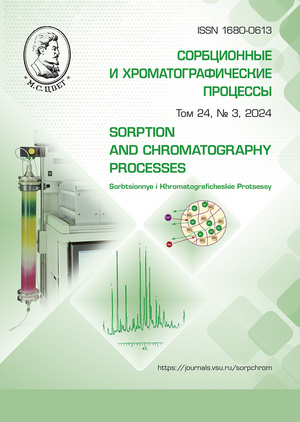Using ion exchange chromatography for the purification of glyoxylate reductase from corn leaves and studying its characteristics
Abstract
The purpose of this study was to obtain a purified preparation of the studied enzyme from corn leaves and to study its characteristics. In this work, kinetic and regulatory parameters of glyoxylate reductase were calculated for leaves of 14-day-old corn (Zea mays) seedlings grown hydroponically at 25°C. The following methods were used during the study: sample homogenisation, four-step purification including ammonium sulphate for desalting, gel filtration on G-25 columns, and ion exchange chromatography using DEAE-sephacel, as well as electrophoresis on polyacrylamide gels and quantitative analysis of protein. To study the properties of the enzyme, we used electrophoretically homogenous preparations. The influence of pH, substrate concentration, and cofactor on the rate of the enzymatic reaction was determined by a series of measurements with different values of the enzymatic reaction rate.
As a result of four-stage purification, we obtained a homogeneous preparation with a specific activity of
167 E/mg of protein. Ion exchange chromatography was important for purification; we obtained 1 peak of enzyme activity upon desorption in 104 mM sodium chloride. Studying the properties of glyoxylate reductase showed a significant dependence of activity on pH. The optimal pH value was 6.5 units.
Downloads
References
Eisenhut M., Roell M.S., Weber A.P.M., Mechanistic understanding of pho-torespiration paves the way to a new green revolution. New Phytol, 2019; 223(4): 1762-1769. https://doi.org/10.1111/nph.15872
Zemljanuhin A.A., Zemljanuhin L.A., Eprincev A.T., Igamberdiev A.U., Glioksi-latnyj cikl rastenij. Voronezh: Izd-vo VGU, 1986, 148 p. (In Russ.)
Westhoff P, Gowik U., Evolution of C4 photosynthesis-looking for the master switch. Plant Physiol. 2010; 154(2): 598-601. https://doi.org/10.1104/pp.110.161729
Kawai S., Mori S., Mukai T., Hash-imoto W., Murata K., Molecular character-ization of Escherichia coli NAD kinase. Eur. J. Biochem. 2001; 268: 4359-4365. https://doi.org/10.1046/j.1432-1327.2001.02358.x
Dellero Y., Jossier M., Schmitz J., MaurinoV. G., Hodges, M., Photorespirato-ry glycolate–glyoxylate metabolism Jour-nal of Experimental Botany, 2016; 67(10): 3041-3052. https://doi.org/10.1093/jxb/erw090
Oberschall A., Deák M., Török K., Sass L., Vass I., Kovács I., Fehér A., Dudits D., Horváth G.V. A novel aldose/aldehyde reductase protects transgenic plants against lipid peroxidation under chemical and drought stresses. The Plant Journal. 2000; 24(4): 437-446. https://doi.org/10.1111/j.1365-313X.2000.00885.x
Givan C. V., Kleczkowski L. A., The enzymatic reduction of glyoxylate and hy-droxypyruvate in leaves of higher plants. Plant Physiol. 1992; 100: 552-556. https://doi.org/10.1104/pp.100.2.552
Gataullina M.O., Eprincev A.T., Vydelenie izoform NAD+-zavisimoj malatdegidrogenazy kukuruzy hromato-graficheskimi metodami. Sorbtsionnye i khromatograficheskie protsessy. 2018; 18(1): 111-117. https://doi.org/10.17308/sorpchrom.2021.21/3475 (In Russ.)
Selemenev V.F., Rudakova L.V., Rudakov O.B., Belanova N.A., Nazarova A.A., Fosfolipidy na fone prirodnyh matric. Voronezh. Novaya kniga. 2020. 318 p. (In Russ.)
Bondareva L.P., Astapov A.V., Sel-emenev V.F., Il'ina A.YU., Celektivnost' ionnogo obmena na iminokarboksil'noj smole i jenergija gidratacii ee ionnyh form. ZHurnal fizicheskoj himii. 2018; 92 (8): 1323-1328. https://doi.org/10.7868/S0044453718080186
Lowry O.H. Protein measurement with the Folin phenol reagent. J. Biologi. 1951; 193: 265-275.
Hoover G.J., Prentice G.A., Merrill A.R., Shelp B.J. Kinetic mechanism of an Arabidopsis glyoxylate reductase: studies of initial velocity, dead-end inhibition and product inhibition. Can. Bot. 2007; 95:896-902. https://doi.org/10.1139/B07-082
Zhang Z., Liang X., Lu L., Xu Z., Huang J., He H., Peng X. Two glyoxylate reductase isoforms are functionally redundant but required under high photorespira-tion conditions in rice. BMC Plant Biology. 2020; 20(1):1-12. https://doi.org/10.1186/s12870-020-02568-0.
Hoover G.J., Jørgensen R., Rochon A., Bajwa V.S., Merrill A.R., Shelp B.J. Identification of catalytically important amino acid residues for enzymatic reduc-tion of glyoxylate in plants. Biochimica et Biophysica Acta (BBA)-Proteins and Pro-teomics. 2013; 1834(12): 2663-2671. https://doi.org/10.1016/j.bbapap.2013.09.013







